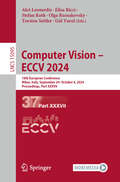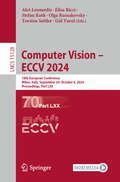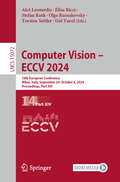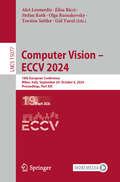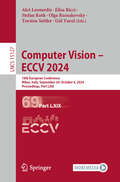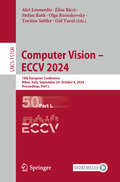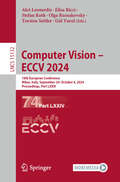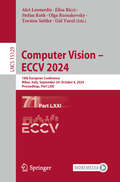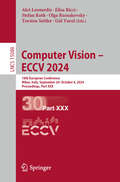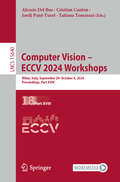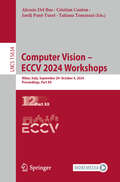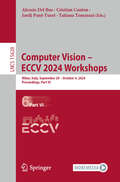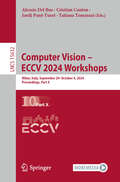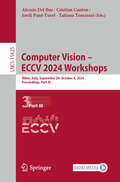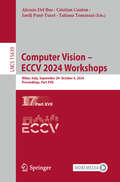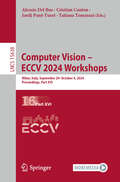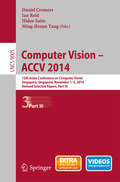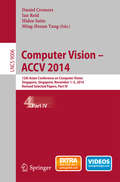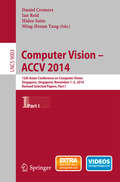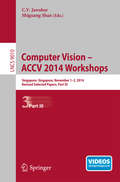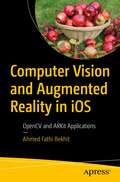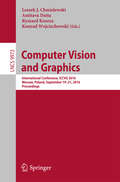- Table View
- List View
Computer Vision – ECCV 2024: 18th European Conference, Milan, Italy, September 29–October 4, 2024, Proceedings, Part XXXVII (Lecture Notes in Computer Science #15095)
by Aleš Leonardis Elisa Ricci Stefan Roth Olga Russakovsky Torsten Sattler Gül VarolThe multi-volume set of LNCS books with volume numbers 15059 up to 15147 constitutes the refereed proceedings of the 18th European Conference on Computer Vision, ECCV 2024, held in Milan, Italy, during September 29–October 4, 2024. The 2387 papers presented in these proceedings were carefully reviewed and selected from a total of 8585 submissions. The papers deal with topics such as computer vision; machine learning; deep neural networks; reinforcement learning; object recognition; image classification; image processing; object detection; semantic segmentation; human pose estimation; 3d reconstruction; stereo vision; computational photography; neural networks; image coding; image reconstruction; motion estimation.
Computer Vision – ECCV 2024: 18th European Conference, Milan, Italy, September 29–October 4, 2024, Proceedings, Part LXX (Lecture Notes in Computer Science #15128)
by Aleš Leonardis Elisa Ricci Stefan Roth Olga Russakovsky Torsten Sattler Gül VarolThe multi-volume set of LNCS books with volume numbers 15059 upto 15147 constitutes the refereed proceedings of the 18th European Conference on Computer Vision, ECCV 2024, held in Milan, Italy, during September 29–October 4, 2024. The 2387 papers presented in these proceedings were carefully reviewed and selected from a total of 8585 submissions. They deal with topics such as Computer vision, Machine learning, Deep neural networks, Reinforcement learning, Object recognition, Image classification, Image processing, Object detection, Semantic segmentation, Human pose estimation, 3D reconstruction, Stereo vision, Computational photography, Neural networks, Image coding, Image reconstruction and Motion estimation.
Computer Vision – ECCV 2024: 18th European Conference, Milan, Italy, September 29–October 4, 2024, Proceedings, Part XIV (Lecture Notes in Computer Science #15072)
by Aleš Leonardis Elisa Ricci Stefan Roth Olga Russakovsky Torsten Sattler Gül VarolThe multi-volume set of LNCS books with volume numbers 15059 up to 15147 constitutes the refereed proceedings of the 18th European Conference on Computer Vision, ECCV 2024, held in Milan, Italy, during September 29–October 4, 2024. The 2387 papers presented in these proceedings were carefully reviewed and selected from a total of 8585 submissions. The papers deal with topics such as computer vision; machine learning; deep neural networks; reinforcement learning; object recognition; image classification; image processing; object detection; semantic segmentation; human pose estimation; 3d reconstruction; stereo vision; computational photography; neural networks; image coding; image reconstruction; motion estimation.
Computer Vision – ECCV 2024: 18th European Conference, Milan, Italy, September 29–October 4, 2024, Proceedings, Part XIX (Lecture Notes in Computer Science #15077)
by Aleš Leonardis Elisa Ricci Stefan Roth Olga Russakovsky Torsten Sattler Gül VarolThe multi-volume set of LNCS books with volume numbers 15059 up to 15147 constitutes the refereed proceedings of the 18th European Conference on Computer Vision, ECCV 2024, held in Milan, Italy, during September 29–October 4, 2024. The 2387 papers presented in these proceedings were carefully reviewed and selected from a total of 8585 submissions. The papers deal with topics such as computer vision; machine learning; deep neural networks; reinforcement learning; object recognition; image classification; image processing; object detection; semantic segmentation; human pose estimation; 3d reconstruction; stereo vision; computational photography; neural networks; image coding; image reconstruction; motion estimation.
Computer Vision – ECCV 2024: 18th European Conference, Milan, Italy, September 29–October 4, 2024, Proceedings, Part LXIX (Lecture Notes in Computer Science #15127)
by Aleš Leonardis Elisa Ricci Stefan Roth Olga Russakovsky Torsten Sattler Gül VarolThe multi-volume set of LNCS books with volume numbers 15059 upto 15147 constitutes the refereed proceedings of the 18th European Conference on Computer Vision, ECCV 2024, held in Milan, Italy, during September 29–October 4, 2024. The 2387 papers presented in these proceedings were carefully reviewed and selected from a total of 8585 submissions. They deal with topics such as Computer vision, Machine learning, Deep neural networks, Reinforcement learning, Object recognition, Image classification, Image processing, Object detection, Semantic segmentation, Human pose estimation, 3D reconstruction, Stereo vision, Computational photography, Neural networks, Image coding, Image reconstruction and Motion estimation.
Computer Vision – ECCV 2024: 18th European Conference, Milan, Italy, September 29–October 4, 2024, Proceedings, Part L (Lecture Notes in Computer Science #15108)
by Aleš Leonardis Elisa Ricci Stefan Roth Olga Russakovsky Torsten Sattler Gül VarolThe multi-volume set of LNCS books with volume numbers 15059 up to 15147 constitutes the refereed proceedings of the 18th European Conference on Computer Vision, ECCV 2024, held in Milan, Italy, during September 29–October 4, 2024. The 2387 papers presented in these proceedings were carefully reviewed and selected from a total of 8585 submissions. The papers deal with topics such as computer vision; machine learning; deep neural networks; reinforcement learning; object recognition; image classification; image processing; object detection; semantic segmentation; human pose estimation; 3d reconstruction; stereo vision; computational photography; neural networks; image coding; image reconstruction; motion estimation.
Computer Vision – ECCV 2024: 18th European Conference, Milan, Italy, September 29 – October 4, 2024, Proceedings, Part LXXIV (Lecture Notes in Computer Science #15132)
by Aleš Leonardis Elisa Ricci Stefan Roth Olga Russakovsky Torsten Sattler Gül VarolThe multi-volume set of LNCS books with volume numbers 15059 upto 15147 constitutes the refereed proceedings of the 18th European Conference on Computer Vision, ECCV 2024, held in Milan, Italy, during September 29–October 4, 2024. The 2387 papers presented in these proceedings were carefully reviewed and selected from a total of 8585 submissions. They deal with topics such as Computer vision, Machine learning, Deep neural networks, Reinforcement learning, Object recognition, Image classification, Image processing, Object detection, Semantic segmentation, Human pose estimation, 3D reconstruction, Stereo vision, Computational photography, Neural networks, Image coding, Image reconstruction and Motion estimation.
Computer Vision – ECCV 2024: 18th European Conference, Milan, Italy, September 29–October 4, 2024, Proceedings, Part LXXI (Lecture Notes in Computer Science #15129)
by Aleš Leonardis Elisa Ricci Stefan Roth Olga Russakovsky Torsten Sattler Gül VarolThe multi-volume set of LNCS books with volume numbers 15059 up to 15147 constitutes the refereed proceedings of the 18th European Conference on Computer Vision, ECCV 2024, held in Milan, Italy, during September 29–October 4, 2024. The 2387 papers presented in these proceedings were carefully reviewed and selected from a total of 8585 submissions. They deal with topics such as computer vision; machine learning; deep neural networks; reinforcement learning; object recognition; image classification; image processing; object detection; semantic segmentation; human pose estimation; 3d reconstruction; stereo vision; computational photography; neural networks; image coding; image reconstruction; motion estimation.
Computer Vision – ECCV 2024: 18th European Conference, Milan, Italy, September 29–October 4, 2024, Proceedings, Part XXX (Lecture Notes in Computer Science #15088)
by Aleš Leonardis Elisa Ricci Stefan Roth Olga Russakovsky Torsten Sattler Gül VarolThe multi-volume set of LNCS books with volume numbers 15059 up to 15147 constitutes the refereed proceedings of the 18th European Conference on Computer Vision, ECCV 2024, held in Milan, Italy, during September 29–October 4, 2024. The 2387 papers presented in these proceedings were carefully reviewed and selected from a total of 8585 submissions. They deal with topics such as computer vision; machine learning; deep neural networks; reinforcement learning; object recognition; image classification; image processing; object detection; semantic segmentation; human pose estimation; 3d reconstruction; stereo vision; computational photography; neural networks; image coding; image reconstruction; motion estimation.
Computer Vision – ECCV 2024 Workshops: Milan, Italy, September 29–October 4, 2024, Proceedings, Part XVIII (Lecture Notes in Computer Science #15640)
by Tatiana Tommasi Alessio Del Bue Cristian Canton Jordi Pont-TusetThe multi-volume set LNCS 15623 until LNCS 15646 constitutes the proceedings of the workshops that were held in conjunction with the 18th European Conference on Computer Vision, ECCV 2024, which took place in Milan, Italy, during September 29–October 4, 2024. These LNCS volumes contain 574 accepted papers from 53 of the 73 workshops. The list of workshops and distribution of the workshop papers in the LNCS volumes can be found in the preface that is freely accessible online.
Computer Vision – ECCV 2024 Workshops: Milan, Italy, September 29–October 4, 2024, Proceedings, Part XII (Lecture Notes in Computer Science #15634)
by Tatiana Tommasi Alessio Del Bue Cristian Canton Jordi Pont-TusetThe multi-volume set LNCS 15623 until LNCS 15646 constitutes the proceedings of the workshops that were held in conjunction with the 18th European Conference on Computer Vision, ECCV 2024, which took place in Milan, Italy, during September 29–October 4, 2024. These LNCS volumes contain 574 accepted papers from 53 of the 73 workshops. The list of workshops and distribution of the workshop papers in the LNCS volumes can be found in the preface that is freely accessible online.
Computer Vision – ECCV 2024 Workshops: Milan, Italy, September 29–October 4, 2024, Proceedings, Part VI (Lecture Notes in Computer Science #15628)
by Tatiana Tommasi Alessio Del Bue Cristian Canton Jordi Pont-TusetThe multi-volume set LNCS 15623 until LNCS 15646 constitutes the proceedings of the workshops that were held in conjunction with the 18th European Conference on Computer Vision, ECCV 2024, which took place in Milan, Italy, during September 29–October 4, 2024. These LNCS volumes contain 574 accepted papers from 53 of the 73 workshops. The list of workshops and distribution of the workshop papers in the LNCS volumes can be found in the preface that is freely accessible online.
Computer Vision – ECCV 2024 Workshops: Milan, Italy, September 29–October 4, 2024, Proceedings, Part X (Lecture Notes in Computer Science #15632)
by Tatiana Tommasi Alessio Del Bue Cristian Canton Jordi Pont-TusetThe multi-volume set LNCS 15623 until LNCS 15646 constitutes the proceedings of the workshops that were held in conjunction with the 18th European Conference on Computer Vision, ECCV 2024, which took place in Milan, Italy, during September 29–October 4, 2024. These LNCS volumes contain 574 accepted papers from 53 of the 73 workshops. The list of workshops and distribution of the workshop papers in the LNCS volumes can be found in the preface that is freely accessible online.
Computer Vision – ECCV 2024 Workshops: Milan, Italy, September 29–October 4, 2024, Proceedings, Part III (Lecture Notes in Computer Science #15625)
by Tatiana Tommasi Alessio Del Bue Cristian Canton Jordi Pont-TusetThe multi-volume set LNCS 15623 until LNCS 15646 constitutes the proceedings of the workshops that were held in conjunction with the 18th European Conference on Computer Vision, ECCV 2024, which took place in Milan, Italy, during September 29–October 4, 2024. These LNCS volumes contain 574 accepted papers from 53 of the 73 workshops. The list of workshops and distribution of the workshop papers in the LNCS volumes can be found in the preface that is freely accessible online.
Computer Vision – ECCV 2024 Workshops: Milan, Italy, September 29–October 4, 2024, Proceedings, Part XVII (Lecture Notes in Computer Science #15639)
by Tatiana Tommasi Alessio Del Bue Cristian Canton Jordi Pont-TusetThe multi-volume set LNCS 15623 until LNCS 15646 constitutes the proceedings of the workshops that were held in conjunction with the 18th European Conference on Computer Vision, ECCV 2024, which took place in Milan, Italy, during September 29–October 4, 2024. These LNCS volumes contain 574 accepted papers from 53 of the 73 workshops. The list of workshops and distribution of the workshop papers in the LNCS volumes can be found in the preface that is freely accessible online.
Computer Vision – ECCV 2024 Workshops: Milan, Italy, September 29–October 4, 2024, Proceedings, Part XVI (Lecture Notes in Computer Science #15638)
by Tatiana Tommasi Alessio Del Bue Cristian Canton Jordi Pont-TusetThe multi-volume set LNCS 15623 until LNCS 15646 constitutes the proceedings of the workshops that were held in conjunction with the 18th European Conference on Computer Vision, ECCV 2024, which took place in Milan, Italy, during September 29–October 4, 2024. These LNCS volumes contain 574 accepted papers from 53 of the 73 workshops. The list of workshops and distribution of the workshop papers in the LNCS volumes can be found in the preface that is freely accessible online.
Computer Vision -- ACCV 2014: 12th Asian Conference on Computer Vision, Singapore, Singapore, November 1-5, 2014, Revised Selected Papers, Part III (Lecture Notes in Computer Science #9005)
by Daniel Cremers Ian Reid Hideo Saito Ming-Hsuan YangThe five-volume set LNCS 9003--9007 constitutes the thoroughly refereed post-conference proceedings of the 12th Asian Conference on Computer Vision, ACCV 2014, held in Singapore, Singapore, in November 2014. The total of 227 contributions presented in these volumes was carefully reviewed and selected from 814 submissions. The papers are organized in topical sections on recognition; 3D vision; low-level vision and features; segmentation; face and gesture, tracking; stereo, physics, video and events; and poster sessions 1-3.
Computer Vision -- ACCV 2014: 12th Asian Conference on Computer Vision, Singapore, Singapore, November 1-5, 2014, Revised Selected Papers, Part IV (Lecture Notes in Computer Science #9006)
by Daniel Cremers Ian Reid Hideo Saito Ming-Hsuan YangThe five-volume set LNCS 9003--9007 constitutes the thoroughly refereed post-conference proceedings of the 12th Asian Conference on Computer Vision, ACCV 2014, held in Singapore, Singapore, in November 2014. The total of 227 contributions presented in these volumes was carefully reviewed and selected from 814 submissions. The papers are organized in topical sections on recognition; 3D vision; low-level vision and features; segmentation; face and gesture, tracking; stereo, physics, video and events; and poster sessions 1-3.
Computer Vision -- ACCV 2014: 12th Asian Conference on Computer Vision, Singapore, Singapore, November 1-5, 2014, Revised Selected Papers, Part I (Lecture Notes in Computer Science #9003)
by Daniel Cremers Ian Reid Hideo Saito Ming-Hsuan YangThe five-volume set LNCS 9003--9007 constitutes the thoroughly refereed post-conference proceedings of the 12th Asian Conference on Computer Vision, ACCV 2014, held in Singapore, Singapore, in November 2014. The total of 227 contributions presented in these volumes was carefully reviewed and selected from 814 submissions. The papers are organized in topical sections on recognition; 3D vision; low-level vision and features; segmentation; face and gesture, tracking; stereo, physics, video and events; and poster sessions 1-3.
Computer Vision - ACCV 2014 Workshops: Singapore, Singapore, November 1-2, 2014, Revised Selected Papers, Part II (Lecture Notes in Computer Science #9009)
by C. V. Jawahar Shiguang ShanThe three-volume set, consisting of LNCS 9008, 9009, and 9010, contains carefully reviewed and selected papers presented at 15 workshops held in conjunction with the 12th Asian Conference on Computer Vision, ACCV 2014, in Singapore, in November 2014. The 153 full papers presented were selected from numerous submissions. LNCS 9008 contains the papers selected for the Workshop on Human Gait and Action Analysis in the Wild, the Second International Workshop on Big Data in 3D Computer Vision, the Workshop on Deep Learning on Visual Data, the Workshop on Scene Understanding for Autonomous Systems, and the Workshop on Robust Local Descriptors for Computer Vision. LNCS 9009 contains the papers selected for the Workshop on Emerging Topics on Image Restoration and Enhancement, the First International Workshop on Robust Reading, the Second Workshop on User-Centred Computer Vision, the International Workshop on Video Segmentation in Computer Vision, the Workshop: My Car Has Eyes: Intelligent Vehicle with Vision Technology, the Third Workshop on E-Heritage, and the Workshop on Computer Vision for Affective Computing. LNCS 9010 contains the papers selected for the Workshop on Feature and Similarity for Computer Vision, the Third International Workshop on Intelligent Mobile and Egocentric Vision, and the Workshop on Human Identification for Surveillance.
Computer Vision - ACCV 2014 Workshops, Part III: Singapore, Singapore, November 1-2, 2014, Revised Selected Papers, Part III (Lecture Notes in Computer Science #9010)
by C. V. Jawahar Shiguang ShanThe three-volume set, consisting of LNCS 9008, 9009, and 9010, contains carefully reviewed and selected papers presented at 15 workshops held in conjunction with the 12th Asian Conference on Computer Vision, ACCV 2014, in Singapore, in November 2014. The 153 full papers presented were selected from numerous submissions. LNCS 9008 contains the papers selected for the Workshop on Human Gait and Action Analysis in the Wild, the Second International Workshop on Big Data in 3D Computer Vision, the Workshop on Deep Learning on Visual Data, the Workshop on Scene Understanding for Autonomous Systems and the Workshop on Robust Local Descriptors for Computer Vision. LNCS 9009 contains the papers selected for the Workshop on Emerging Topics on Image Restoration and Enhancement, the First International Workshop on Robust Reading, the Second Workshop on User-Centred Computer Vision, the International Workshop on Video Segmentation in Computer Vision, the Workshop: My Car Has Eyes: Intelligent Vehicle with Vision Technology, the Third Workshop on E-Heritage and the Workshop on Computer Vision for Affective Computing. LNCS 9010 contains the papers selected for the Workshop on Feature and Similarity for Computer Vision, the Third International Workshop on Intelligent Mobile and Egocentric Vision and the Workshop on Human Identification for Surveillance.
Computer Vision and Audition in Urban Analysis Using the Remorph Framework (Studies in Systems, Decision and Control #192)
by Mohammad Ali Nematollahi Samaneh Shahbazi Nashid NabianArtificial Intelligence (AI) is penetrating in all sciences as a multidisciplinary approach. However, adopting the theory of AI including computer vision and computer audition to urban intellectual space, is always difficult for architecture and urban planners. This book overcomes this challenge through a conceptual framework by merging computer vision and audition to urban studies based on a series of workshops called Remorph, conducted by Tehran Urban Innovation Center (TUIC).
Computer Vision and Augmented Reality in iOS: OpenCV and ARKit Applications
by Ahmed Fathi BekhitLearn how computer vision works, how augmented reality renders digital graphics into the physical world via an iPhone’s camera, and how to incorporate these technologies into your own apps. This book shows you how to take full advantage of computer vision technologies.Interacting with other people online usually involves user-generated images and videos; whether it be “memes”, short videos, or heavily-modified images. Before smart phones, generating this content required a professional using high-level image and video editing software. Not any more. This book will teach you to use computer vision in the most popular ways, such as for facial recognition, image to text analysis and, of course, recording a video of a dancing hot dog in your living room. Starting with the history of computer vision, image and video processing fundamentals, and an introduction to developing augmented reality applications, you’ll learn to incorporate computer vision both in the content you create and the apps you develop for end users. Computer Vision and Augmented Reality in iOS reveals how every user with access to the Internet and a smart phone can easily generate heavily-modified images and videos. What You'll LearnIncorporate mathematics related to computer vision into your appsHost computer vision models remotely for mobile useImplement visual-inertial state estimation algorithms for mobile augmented realityWho This Book Is ForProfessionals or post graduate students in software development or engineering who have a basic understanding of how software development works and are interested in implementing computer vision into their development. It's recommended that readers already have a working knowledge of C++ and Swift.
Computer Vision and Graphics: International Conference, ICCVG 2016, Warsaw, Poland, September 19-21, 2016, Proceedings (Lecture Notes in Computer Science #9972)
by Leszek J. Chmielewski Amitava Datta Ryszard Kozera Konrad WojciechowskiThis book constitutes the thoroughly refereed post-conference proceedings of the International Conference on Computer Vision and Graphics, ICCVG 2008, held in Warsaw, Poland, in November 2008. The 48 revised full papers presented were carefully reviewed and selected from numerous submissions. The papers are organized in topical sections on image processing, image quality assessment, geometrical models of objects and scenes, motion analysis, visual navigation and active vision, image and video coding, virtual reality and multimedia applications, biomedical applications, practical applications of pattern recognition, computer animation, visualization and graphical data presentation.
Computer Vision and Graphics: International Conference, ICCVG 2020, Warsaw, Poland, September 14–16, 2020, Proceedings (Lecture Notes in Computer Science #12334)
by Leszek J. Chmielewski Ryszard Kozera Arkadiusz OrłowskiThis book constitutes the refereed proceedings of the International Conference on Computer Vision and Graphics, ICCVG 2020, held in Warsaw, Poland, in September 2020. The 20 full papers were selected from 49 submissions. The contributions cover topics such as: modelling of human visual perception; computational geometry; geometrical models of objects and scenes; illumination and reflection models and methods; image formation; image and video coding; image filtering and enhancement; biomedical image processing; biomedical graphics; colour image processing; multispectral image processing; pattern recognition in image processing; scene understanding; motion analysis, visual navigation and active vision; human motion detection and analysis; visualisation and graphical data presentation; hardware and architectures for image processing; computer-aided graphic design; 3D imaging, shading and rendering; computer animation; graphics for internet and mobile systems; virtual reality; image and video databases; digital watermarking; multimedia applications; and computer art. Due to the Corona pandemic ICCVG 2020 was held as a virtual event.
